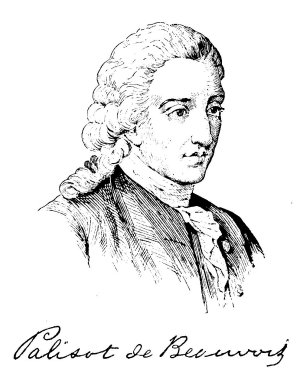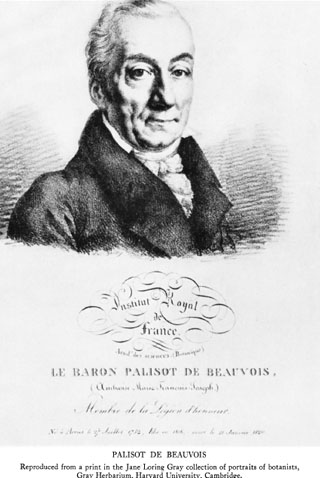

Ambroise
Marie Francois Joseph Palisot,
Baron de Beauvois
|
|
Ambroise Marie Francois Joseph
Palisot, Baron de Beauvois made collections of insects…
“within the realms of Oware, Benin, Saint Domingue, and
the États Unis, during the years 1786 – 1797…”
Although he was a botanist by training, Palisot published a
major entomological work entitled, “Insectes Recueillis
en Afrique et en Amerique.” Palisot’s work is significant
because, while some workers had described American beetles before
him, he was one of the first to both actively collect and describe
American insects along with his contemporary, Fredrick Melsheimer
(the elder). In addition to the hundreds of common insects that
he described, the work is also notable for his proposed ordinal
classification of Insects. A large number of Scarabaeidae are
included in this work, many described and/or illustrated for
the first time. The total includes 39 species in the genus Scarabaeus,
17 species of Copris, seven species of Trox,
four Cetonia and four Trichius. Among these
were the first descriptions of such familiar beetles as
Canthon viridis (P.B.), Macrodactylus angustatus
(P.B.) and Osmoderma scabra (P.B.). A problem, for
reasons discussed below, is that many of the species that Palisot
attributed to “Amérique” were actually collected in
“Afrique,” and vice versa. Moreover, he included species,
such as Dynastes hercules (L.), which do not occur
within the U.S. or Santo Domingo, creating type localities for
species that in some cases are outside of their natural range.
Details of Palisot’s travels
are provided by Chase (1925) and Merrill (1937), among others,
and can be briefly summarized here, by way of explaining why
uncertainty exists as to the origin of his material. Born in
France, Palisot was trained as a lawyer but pursued postgraduate
studies in botany under Lestiboudois in Lille and Jussieu in
Paris. He left France in the year 1786 with an expedition to
found a colony at Oware (or Owerri) at the mouth of the Niger
River in what is today Nigeria. Palisot assembled material from
there with some collections from the neighboring country of
present-day Benin. From time to time Palisot sent specimens
back to France, but the bulk of his collections were destroyed
when the British pillaged the colony and set fire to the trading
post where his material was stored. An outbreak of yellow fever
ravaged the colonists, and Palisot became so ill with the disease
that in 1788 his friends placed him on a slave ship bound for
Haiti where he had an uncle. The uncle’s house was in Cape
Francais, and there Palisot recuperated and resumed his botanical
and entomological collecting, on occasion sending specimens
back to France. Yet again disaster struck when, in 1793, the
slaves revolted and burned the town, including his uncle’s
house where his collections were stored. Palisot was imprisoned,
but through the intercession of a mulatto woman he was freed
under order of deportation. Because of the French revolution
and his former status in the nobility as the Baron de Beauvois,
Palisot was unable to return to France without risking the guillotine.
Instead he boarded a ship bound for the United States but, en
route, was relieved of his remaining belongings by pirates and
thus he arrived in Philadelphia penniless and bereft. He was
able to make a living by joining a circus as a musician, but
he eventually returned to work as a botanist, hired to curate
the private collection of C.W. Peale.
In Philadelphia he became a member
of the American Philosophical Society, published in its Transactions,
and resumed his natural history collecting with the financial
support of the French Attache, Paul Adet, a scientist in his
own right. Palisot’s collecting forays in the United States
ranged as far west as the Ohio River and as far south as Savannah,
Georgia. When finally notified by colleagues in Paris that his
citizenship had been restored, Palisot began making plans for
his return to Europe, including arrangements for the shipment
of his specimens. Unfortunately, these collections were lost
when the ship carrying them sank off the coast of Nova Scotia
in 1798. He left the United States that same year and returned
to his native France.
Based on the material that had survived prior shipments, but
mainly on his sketches, Palisot published works on plants and
insects, the latter in a series of 15 booklets (livraisons)
issued between 1805 and 1821, the last issued one year after
his death. Griffin (1932, 1937) provides the dates of issue
for each individual livraison. Each livraison included five
to six plates, each with illustrations of six or nine of the
insects described in the text, and it is on these sketches rather
than actual specimens that Palisot’s species are often
recognized.
Few of Palisot’s specimens
are extant. His botanical collection was sent from Paris to
the herbarium of the Jardin Botanique at Geneva, Switzerland
(Merrill 1937). The herbarium at the Philadelphia Academy of
Natural Sciences has sheets that are marked “Beauv.”,
but these are plants native to India, a place never visited
by Palisot. Hence, Palisot must have received specimens collected
by others, and this could help explain the mysterious origin
of some of his insect material. According to Horn & Kahle
(1937) some of Palisot’s beetle specimens, specifically
the Elateridsae, were sent by Dejean to Godman and Salvin at
the British Museum of Natural History for inclusion in the Biologia
Centrali-Americana. Other specimens were sent by Chevrolat to
Neervoort Van de Poll of the Netherlands. Van de Poll’s
collection was eventually bequeathed to the BMNH as well, but
none of Palisot’s specimens have been found there. Logically,
any remaining specimens should be housed at the Museu National
d’Histoire Naturelle in Paris, but to my knowledge, no
systematic search has been made for Palisot’s material
(Dominique Pluot-Sigwalt, pers. comm.). Of course, in the event
that any of Palisot’s specimens should be discovered, and
if it should turn out that his species are different from the
traditional interpretation, it is possible that his names could
be synonyms or homonyms of known species.
Biographical sketch contributed by Don Thomas (USDA, Weslaco,
Texas) with information from the references below.
References
Chase, A. 1925. Biographical Sketch. Contributions of the U.S.
National Herbarium 24: 210-214.
Griffin, F.J. 1932. On the dates
of publication of “Palisot de Beauvois, Insectes rec. Afr.
Amer.” 1805-1821. Annals and Magazine of Natural History
10: 585-586.
Griffin, F.J. 1937. A further
note on “Palisot de Beauvois, Insectes Rec. Afr. Amer.”
1805-1821. Journal of the Society of Bibliography of Natural
History 1: 121-122.
Horn, W. & I. Kahle 1937.
Uber entomologische Sammlungen, Entomologen & Entomo-Museologie.
Entomologische Beihefte Berlin-Dahlem. 3 vols., 536 pp.
Merrill, E.D. (1937). Palisot
de Beauvois as an overlooked American botanist. Proceedings
of the American Philosophical Society 76: 899-920.
Palisot de Beauvois, A.M.F.J.
(1805-1821). Insectes recueillis en Afrique et en Amérique dans
les royaumes d’Oware et de Benin, á Saint-Domingue et dans
les États Unis, pendant les années 1786-1797. Paris, 267 pp. |